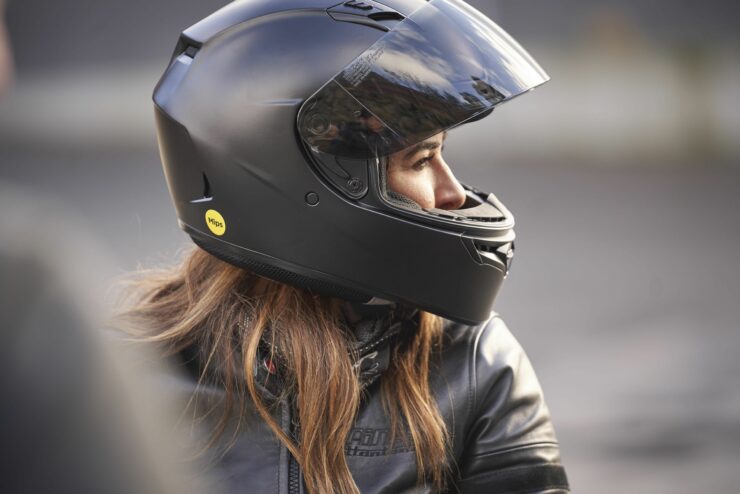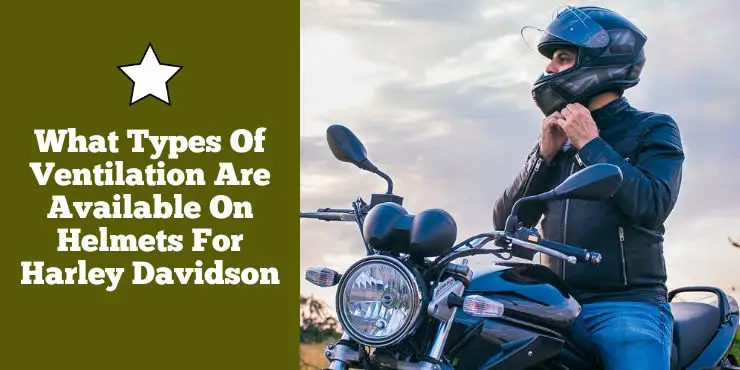Are you ready to ride? Before you hit the open road, you should consider the type of ventilation available on your Harley-Davidson helmet. In this article, we’ll explore the different ventilation options available for Harley-Davidson helmets. Whether you’re looking to stay cool while cruising down the highway, or just need a breath of fresh air, you’ll find the information you need to choose the perfect helmet for your ride. So buckle up and let’s take a look at the different ventilation options available for your Harley-Davidson helmet.
What is the importance of ventilation for motorcycle helmets?
When talking about head protection, helmets play a key role in ensuring the safety of individuals when riding a bike. While helmet design and materials are often the major topics of discussion in terms of safety, another key aspect that shouldn’t be overlooked is helmet ventilation. Helmet ventilation refers to the intentional inclusion of airflow channels and vents within the helmet’s structure to allow for the exchange of air.
>>> Click here to read our review of the Best Helmet For Harley-Davidson <<<
Helmet ventilation involves strategically placing vents and channels designed to facilitate the movement of air within the helmet. These vents allow fresh air to enter the helmet while allowing warm, moist air to exit. The aim here is to create a cooling effect, prevent heat buildup, and maintain a comfortable environment for the rider’s head.
The main purpose of helmet ventilation will be to regulate temperature and humidity inside the helmet. During physical activities or in hot environments, the body generates heat, which can result in discomfort and sweating, and potentially compromise safety. A well-ventilated helmet helps dissipate excess heat, reduces the risk of overheating, and allows you to maintain a more stable body temperature. Further, proper ventilation in a helmet also helps manage moisture and perspiration accumulation.
Sweating is a natural response to physical exertion and without proper airflow, sweat can easily accumulate. This can result in discomfort, skin irritation, and impaired vision. By allowing air to flow through the helmet, ventilation helps evaporate sweat to keep the interior dry, enhancing overall comfort, and reducing the potential for distractions during activities.
Aside from comfort, helmet ventilation also plays a major role in safety. An overheated and uncomfortable head can result in decreased focus and concentration, increasing the risk of accidents. Moreover, excessive heat buildup inside the helmet can contribute to dizziness, fatigue, and other physiological responses that can impair cognitive and motor functions. By promoting air circulation, helmet ventilation helps maintain alertness and cognitive performance, allowing individuals to stay focused on the ride. It is especially vital in high-intensive activities like riding a Harley-Davidson motorcycle where the ability to make split-second decisions and react quickly is important for safety.

What types of ventilation are available on helmets for Harley-Davidson bikers?
Harley-Davidson motorcycles have long been synonymous with power, freedom, and the open road. A vital part of the riding experience is ensuring your comfort and safety. A helmet with proper ventilation will be a necessity for any Harley-Davidson enthusiast. Motorcycle helmets are an essential piece of protective gear for bikers as they provide crucial head protection in the event of an accident. However, wearing a helmet for extended periods could become uncomfortable because of heat and humidity buildup.
This is where ventilation systems come into the picture. Harley-Davidson helmets have different types of ventilation so you need to know what types of ventilation are available on helmets for Harley-Davidson bikers. Here are the different types of ventilation available to help you make a smarter decision when choosing your gear.
#1. Top ventilation
Top ventilation is a common type of ventilation system found in motorcycle helmets. It consists of intake vents located on the top of the motorcycle helmet’s shell. These vents allow fresh air to enter the motorcycle helmet, circulating around the biker’s head and reducing heat buildup. The air enters through the vents and flows through different channels within the helmet, providing a cooling effect.
#2. Chin ventilation
Chin ventilation is another popular type of ventilation in motorcycle helmets. Located on the chin bar, these vents provide a direct flow of air onto the rider’s face and mouth area. Chin vents are especially useful for bikers who wear full-face helmets as they help prevent the visor from fogging up by directing air toward the shield. This type of ventilation system also helps in reducing moisture and maintaining a comfortable riding experience.
#3. Rear ventilation
Rear ventilation systems consist of exhaust vents located at the back of the motorcycle helmet. These vents work in conjunction with the intake vents, creating a flow of air that helps remove warm, stale air from inside the helmet. Rear vents play a key role in heat dissipation, allowing hot air to escape and maintaining a comfortable temperature for the rider.
#4. Side ventilation
Side ventilation refers to vents positioned on the sides of the helmet. These helmets allow air to flow in from the sides and circulate around the rider’s head. Side vents work together with the other ventilation systems to offer an effective cooling effect and prevent heat buildup. Moreover, they also contribute to the overall airflow and ventilation within the helmet.
#5. Visor ventilation
Visor ventilation systems are designed for enhancing airflow and reducing fogging on the helmet’s visor or shield. These vents are located in the vicinity of the visor and help direct air across its surface, preventing condensation and maintaining clear visibility. Visor ventilation is especially beneficial during colder weather or in high-humidity conditions as it reduces the risk of impaired vision due to fogging.
#6. Internal channeling
Internal channeling refers to the pathways and channels present within the helmet that guide the airflow. These channels are strategically placed for optimizing the circulation of air, directing it from the intake vents to the exhaust vents. By channeling the airflow effectively, these ventilation systems maximize the cooling and ventilation capabilities of the helmet.
It is important to note that different helmets feature different types of ventilation. The design and features of each helmet vary and manufacturers incorporate ventilation systems based on the specific helmet’s intended purpose and style. Riders must consider their riding preferences, climate conditions, and the level of ventilation needed when choosing the helmet. When selecting the helmet, it’ll be important to try it on and assess how well the ventilation works for your comfort. A well-ventilated helmet helps in regulating temperature, reduces sweat buildup, and keeps the rider cool and focused during long rides.
Traditional ventilation in helmets for Harley-Davidson riders
When it comes to Harley-Davidson motorcycle helmets, riders have a wide range of options to choose from based on their needs and preferences. While full-face helmets offer the most comprehensive protection, open face helmets and half helmets offer an entirely different riding experience and a unique ventilation approach often deemed to be traditional ventilation.
Open face helmets
Open-face helmets or also called three-quarter helmets are a popular choice among Harley-Davidson riders who prefer a sense of freedom and a more traditional riding experience. These helmets cover the top, sides, and back of the head, leaving your face exposed. The open face design offers a wider field of vision and allows for better interaction with the surroundings.
In terms of ventilation, open face helmets truly excel in offering ample airflow. The absence of a chin bar and the openness of the design allow air to freely flow over your face. This natural ventilation helps dissipate head and keeps you cool during rides, especially in warmer weather or low-speed situations. However, it is worth noting that open face helmets might not offer the same level of protection as full-face helmets as the face is exposed to potential impacts.
Half helmets
Half helmets or beanies are the most minimalistic option available for Harley-Davidson riders. These helmets cover only the top portion of the head, leaving the face, ears, and back of the head exposed. Half helmets come with a lightweight and compact design, making them a popular option among bikers who prioritize freedom and minimal obstruction.
Half helmets rely on the absence of a solid shell to allow better airflow and better ventilation. The design allows air to circulate more freely, resulting in a cooling effect during rides. Riders who prefer the sensation of wind on their face and a more “open-air” experience prefer going for half helmets. However, it is important to note that these helmets offer minimal protection compared to some other helmet types and they’re more suited for low-speed or casual riding.
While open face helmets and half helmets offer riders excellent ventilation, it is important to consider the trade-off in terms of safety. The exposed face and reduced coverage can often leave riders vulnerable to impacts and potential injuries. Bikers going for these helmet types must consider riding conditions, personal preferences, and the level of protection required.
Modern ventilation in helmets for Harley-Davidson riders
As technology has evolved, so have the design and functionality of motorcycle helmets. One particular area where significant improvements have been made is in the ventilation systems. Proper ventilation is important for rider comfort, preventing heat buildup, and ensuring clear visibility. Here are some of the modern ventilation options found in motorcycle helmets for Harley-Davidson riders these days –
Air vents
Air vents are strategically placed openings present on the helmet’s outer shell and they allow fresh air to enter. The vents act as the primary source of airflow, introducing outside air into the helmet’s interior. Manufacturers carefully position these vents to optimize air circulation and cooling.
Typically, air vents are located on the front, top, and sides of the helmet. The size and number of vents vary depending on the brand and helmet model. They can be opened or closed via adjustable sliders or switches to control the airflow based on weather conditions and rider preference.
Vent channels
Vent channels are internal pathways within the helmet that direct airflow from the air vents to different areas of the helmet. These channels distribute the incoming air across the rider’s head, ensuring optimal ventilation.
These are strategically designed to guide the air to specific areas that are prone to heat buildup, such as the forehead and the crown of the head. By channeling the airflow effectively, vent channels enhance the cooling efficiency and improve overall comfort during rides.
Exhaust channels
Exhaust channels work in conjunction with air vents and vent channels to facilitate the exit of warm, moist air from the helmet. Located at the rear or sides of the helmet, exhaust channels create a path for the expelled air to flow out.
As fresh air enters through the air vents and circulates through the vent channels, it absorbs heat from the rider’s head. The warm air then rises and gets channeled out through the exhaust channels, creating a continuous flow of air and preventing heat buildup within the helmet.
The design of exhaust channels is important for ensuring an effective ventilation system. Helmet manufacturers employ different techniques, such as sculpting the EPS foam liner or incorporating specific shapes and angles in the helmet’s shell for optimizing the exhaust airflow.

Performance-based ventilation in helmets for Harley-Davidson riders
When talking about motorcycle helmets, ventilation plays a key role in ensuring rider comfort, especially during long rides or in challenging weather conditions. While all helmets feature some level of ventilation, performance-based ventilation systems take things one step further by optimizing airflow and providing maximum cooling and rider satisfaction. Here is how performance-based ventilation components work and their features –
Intake vents
Intake vents are strategically positioned openings on the front or sides of the helmet’s shells. Their primary function will be to allow fresh air to enter the helmet and circulate around the rider’s head. Intake vents play an important role in improving airflow, preventing heat buildup, and providing cooling effects.
Manufacturers carefully design intake vents for maximizing the amount of air entering the helmet while minimizing turbulence and noise. They incorporate aerodynamic features or mesh screens for ensuring a smooth airflow path and filtering out debris.
Intake vents are especially beneficial during warmer weather or when riding at higher speeds. The influx of fresh air keeps the rider cool, reduces sweat accumulation, and enhances overall comfort.
Top vents
Top vents, as the name suggests, are located on the top of the helmet’s shell. These vents serve as additional points of entry for fresh air. Top vents are designed for directing air onto the rider’s head, ensuring optimal cooling.
The positioning of top vents takes advantage of the wind’s natural direction during riding. As the bike moves forward, air flows over the top of the helmet and the top vents capture and channel the airflow into the helmet’s interior.
By incorporating top vents into the helmet design, manufacturers enhance the overall ventilation system. The combination of intake vents and top vents creates a dynamic airflow, effectively cooling the rider’s head and maintaining a comfortable temperature.
Rear exhaust vents
Rear exhaust vents or exhaust ports are located at the back or sides of the helmet. These vents serve as outlets for warm, moist air to escape from the helmet, preventing heat buildup and ensuring proper ventilation.
As fresh air enters through the intake vents and flows through the helmet, it absorbs heat from the rider’s head. The warm air naturally rises and gets expelled through the rear exhaust vents. This continuous airflow cycle effectively removes hot, stale air and helps maintain a cooler environment inside the helmet.
The design of the rear exhaust vents is important for optimal performance. Manufacturers employ various techniques, such as angling the vents or incorporating channels within the helmet’s interior to facilitate the smooth and efficient flow of warm air out of the helmet.
Accessories for improved ventilation in motorcycle helmets
Riding a Harley-Davidson motorcycle is an exhilarating experience but it often comes with challenges like wind noise, drafts, and insufficient ventilation inside the helmet. For addressing these issues and improving rider comfort, different accessories have been developed. These accessories are specifically meant for enhancing ventilation in motorcycle helmets. Here are some of those accessories for improved ventilation in motorcycle helmets –
#1. Neck curtain
A neck curtain is a removable accessory that attaches to the bottom edge of a motorcycle helmet. It is designed to provide additional coverage around the rider’s neck, sealing the gap between the helmet and the jacket collar. While its primary purpose is to block wind and keep the neck area protected, a neck curtain also plays a pivotal role in improving ventilation.
By creating a barrier between the rider’s neck and the wind, a neck curtain will help in minimizing drafts and the entry of cold air into the helmet. This contributes to better overall insulation and reduces the chances of wind-related discomfort and heat loss. Moreover, a neck curtain can also prevent dust, debris, and insects from entering the helmet, improving the overall riding experience.
#2. Chin wind deflector
A chin wind deflector is a small accessory that essentially attaches to the lower section of the helmet, specifically around the chin bar area. It is meant to redirect the airflow and reduce turbulence that can cause discomfort and noise.
The chin wind deflector works by creating a smoother airflow around the chin bar, essentially reducing the amount of wind hitting the rider’s face. This accessory helps to minimize the feeling of wind pressure and prevents excessive air from entering the helmet through the chin area. By improving aerodynamics and reducing turbulence, the chin wind deflector helps in enhancing ventilation and rider comfort.
#3. Windscreen
A windscreen or also known as a visor or shield is a transparent or tinted accessory that covers the front of the helmet, extending down from the forehead area. While designed primarily for protecting the rider’s face from wind, debris, and UV rays, a windscreen also plays a key role in ventilation.
A well-designed windscreen will help to create a barrier against excessive airflow, reducing wind noise and preventing turbulence inside the helmet. By blocking the direct impact of the wind, the windscreen enables smoother airflow around the helmet, contributing to better ventilation and reducing the chance of excessive air entering the helmet through the visor gap.
Further, some modern windscreen designs also feature adjustable or vented options. These allow riders to customize the amount of airflow entering the helmet, providing better control over ventilation depending on weather conditions and personal preference.
When considering these accessories for improved ventilation, it will be important to ensure compatibility with the helmet model. Moreover, riders must ensure that the accessories don’t obstruct their vision or compromise the overall safety of the helmet.

FAQ
What are the different types of ventilation available on helmets for Harley Davidson?
Helmets for Harley Davidson come with several types of ventilation, including intake vents, exhaust vents, and chin vents. Intake vents draw in fresh air and help to keep the rider cool, while exhaust vents allow hot air to escape and keep the rider comfortable. Chin vents provide an additional air intake, which helps to maintain an optimum temperature inside the helmet.
What are the benefits of having good ventilation on a helmet?
Having good ventilation on a helmet can provide several benefits, including improved comfort, reduced fogging, and better hearing. Good ventilation also helps to keep the rider cool and reduce sweat buildup, allowing for a more enjoyable ride.
What other features should I consider when choosing a helmet for Harley Davidson?
When choosing a helmet for Harley Davidson, you should also consider features such as shell construction, fit, and weight. It is important to select a helmet that fits properly and is lightweight, as this can help to improve comfort and performance. As well, look for a helmet with a durable shell construction to ensure it provides the necessary protection in the event of an accident.q
>>> Read more about Helmets for Harley-Davidson Riders <<<


